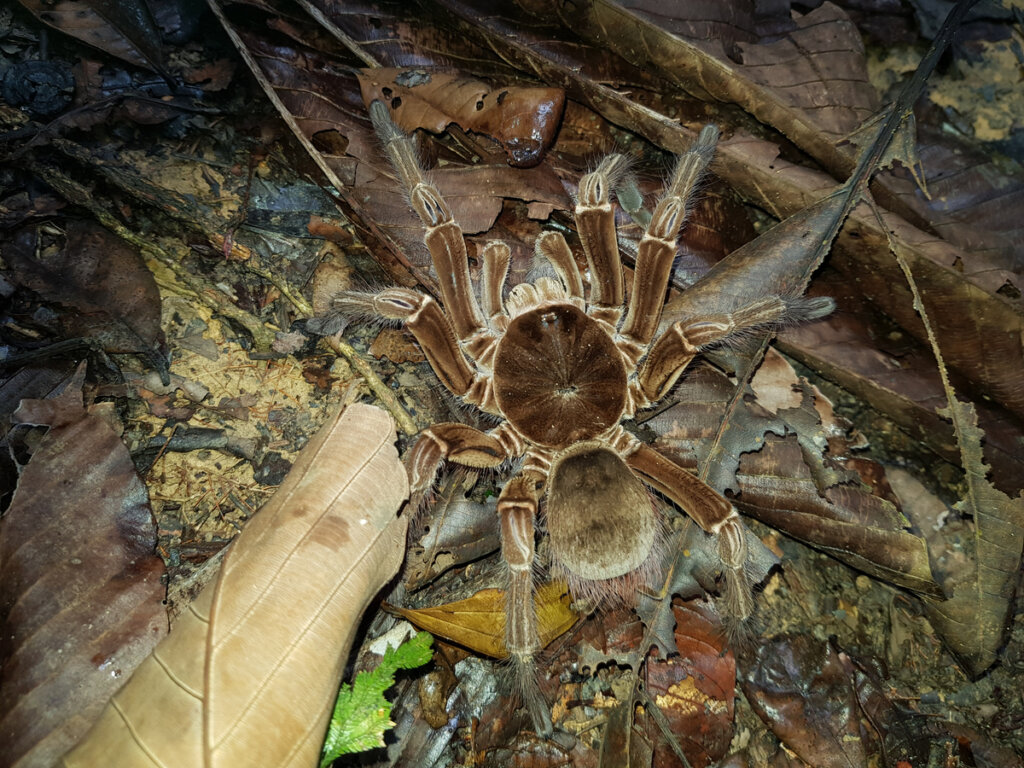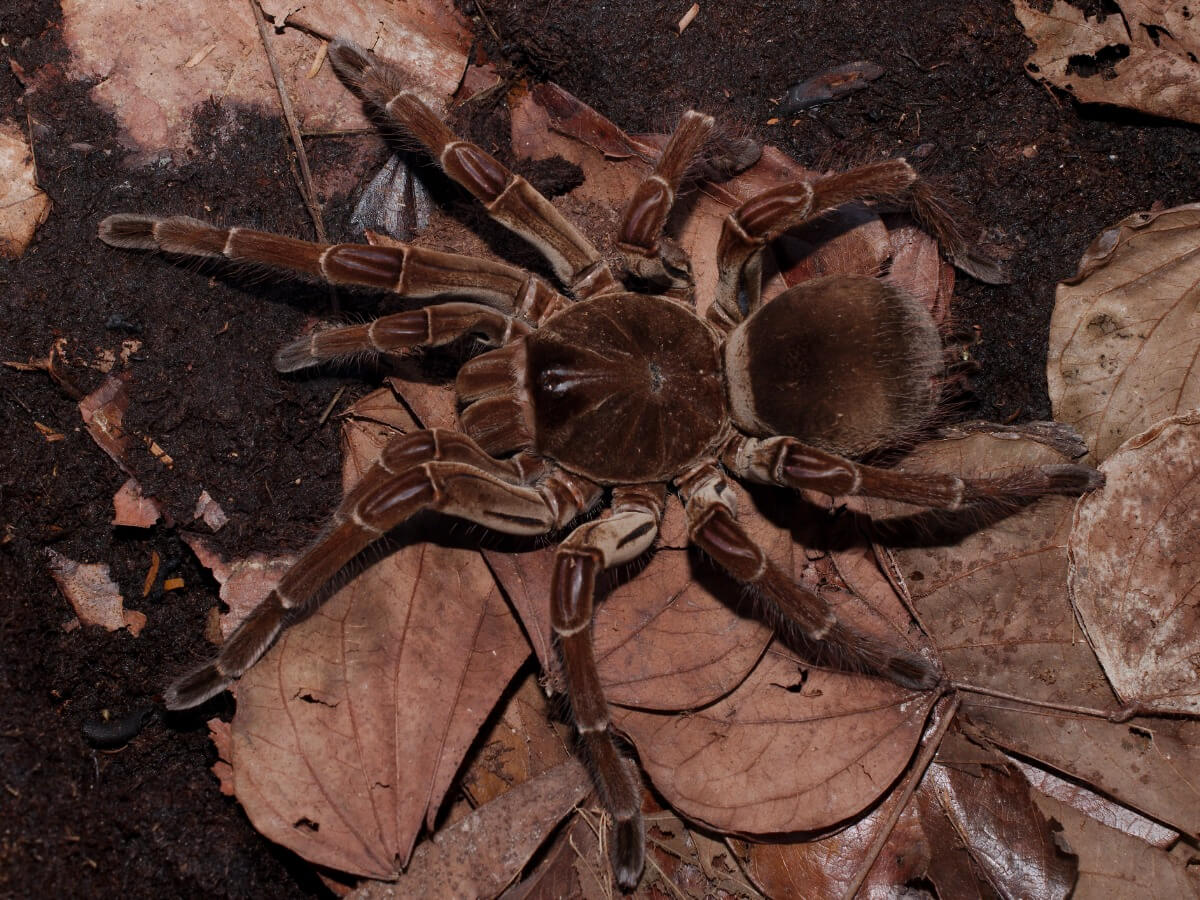Goliath Birdeater Spider: Habitat and Characteristics

The Goliath birdeater spider is an invertebrate recognized for being one of the largest in existence. In fact, this arachnid became famous a long time ago, due to a video in which it was recorded feeding on a hummingbird, which is why it’s known as a “birdeater”. Although this behavior is rare, its size helps it to cope with unusual prey.
This arachnid belongs to the group of theraphosids, whose colorations are usually opaque or dark, and which also share characteristics with the rest of the tarantulas that inhabit the world. Specifically, in this article, we’ll refer to Theraphosa blondi, a hairy giant that will amaze you! Read on to learn more about this invertebrate.
Goliath birdeater spider habitat
These arachnids are distributed throughout South America, being abundant in French Guyana, Suriname, Brazil, and Venezuela, which comprise part of the Amazon. The natural habitat of the species is located in swampy areas with jungle vegetation, which are abundant in this equatorial region. Being a terrestrial organism, the vegetation serves as a refuge and allows it to be on the lookout for its prey.
Goliath spider characteristics
This spider’s body is divided into two well-differentiated parts: the prosoma and the opisthosoma. The frontal region or prosoma, which is a fusion between the head and the neck, is the place that holds all the extremities. On the other hand, the abdomen or opisthosoma is usually more prominent, and it’s here where you’ll find the silk gland that allows it to weave its web.
This huge invertebrate is the largest spider in the world taking into account its weight and size (the giant huntsman spider has a larger leg span). It can reach up to 18 centimeters (7 inches) long with its body. However, this seems small when compared to the almost 12 inches in length it can reach if measured from leg to leg.
As we mentioned before, this species currently holds the Guinness record for being the “largest spider in the world”.
One particular characteristic of this arachnid is that it has a lot of hair on its body. These filaments serve as sensors that allow it to detect the slightest movement, making it easier for it to hunt. This is because, despite the fact it has eyes, its vision isn’t very good. On the other hand, its color can vary between dark brown and light brown tones.

It only has 8 legs
There has often been a lot of confusion regarding the number of legs it has, as it can appear to have 10. However, this is because the first 2 limbs are not for movement, but they serve as “hands” that allow it to grab things.
Moreover, if we want to get even more specific, we could say that theraphosids have 12 extremities in total, which starting from the mouth backwards, are arranged as follows:
- Chelicerae: There are 2 of these, and they’re better known as “jaws”. They serve to inject the poison and to paralyze their victims. They’re found just after the mouth and also act as a protective weapon.
- Pedipalps: There are also 2 of these, but, unlike the previous ones, they look like a normal pair of legs, only shorter. These limbs serve almost like hands to grab their prey and they play an important role in reproduction.
- Locomotive legs: These are the “true legs”, which consist of 4 pairs, the usual ones within the group of spiders. All of them help this animal to move and the last pair is found just before the prosoma ends.
Character and behavior
Goliath spiders are solitary organisms that live hidden in burrows, and are most active at night. In fact, although these arachnids are considered aggressive, they only attack when the threat ignores their warnings. Its signal consists of a stridulation, which is produced by rubbing the legs on the abdomen, thereby warning of its presence and its danger.
Goliath birdeater spider venom
Although tarantulas, in general, have a bad reputation for being very poisonous, the reality is that few are dangerous to humans. Despite this, the bite is still quite painful, due to the size of the chelicerae (2-4 centimeters). However, the effects of the venom of this species can be similar to the sting of a simple wasp.
Furthermore, far from their large size and fierce appearance, the toxins produced by these arachnids can be used for medical purposes. Specifically, the poison of the Goliath birdeater spider could have therapeutic effects, since one of its components serves as a type of paralysis.
Goliath birdeater spider feeding
Although its fame given it its name as a “bird-eating spider”, this invertebrate doesn’t usually hunt this type of prey. Their diet is actually based on frogs, lizards, small snakes, and insects, with bats and some small birds being the rarest prey on the list.
Moreover, some consider that this species is more of an opportunist, as it seeks to obtain the best benefit with the lowest energy expenditure. Various scientific works have shown this behavior, in which specimens of the Goliath birdeater spider take advantage of the traps set by the researchers to have a feast. Some victims of these events have been birds and snakes.
Reproduction of the Goliath birdeater spider
To carry out the mating, the male must follow a series of steps in order to succeed in courting the female, as it runs the risk of being eaten by her. This is why it begins by beckoning her from afar, raising and lowering his pedipalps or hitting the ground with force, in a process known as drumming.
Once he gets her attention, the male begins to move his body, almost as if he were vibrating, which seems to be necessary to get himself recognized among all the specimens of the opposite sex. This ensures that they won’t mate with other species, because, as their vision is so bad, they have no other clue about the species other than the sensitive hairs on their bodies. Because of this, they have developed this interesting routine.
If the female accepts copulation, she’ll respond with light strokes between her legs, which will also tell the male her location and distance. With this, the couple begins the mating approaching each other, while the male lifts the female a little, revealing her abdomen. This is done in order to insert his sperm into the oviduct, making use of both pedipalps.
Oviposition and incubation of eggs
Once the complex mating ritual is over, the male escapes as quickly as possible, because the female may choose to eat him! However, this doesn’t often happen as the female is usually in a cataleptic (rigid) and immobile state.
After a few days, being an oviparous species, the mother will lay around 150 eggs, which she’ll wrap in a silk sack, and then she’ll hide inside her burrow. The female begins to behave more aggressively in order to defend her young, as they’ll take between 6 and 8 weeks to hatch.
State of conservation
Currently, the Goliath birdeater spider isn’t listed as part of the endangered species. However, this is mainly due to a lack of information. In addition, we know that their habitat is at risk, as the Amazon is one of the places with the greatest ecological pressure due to its destruction.
In addition to this, most theraphosids face a serious problem with illegal trade, as they’re hunted and often found in local markets. According to some experts, the latter may not be a great risk, because the reproductive success of these organisms is very high. However, the sum of several factors can end up endangering these invertebrates.
There are several traditional uses for the fangs of Goliath spiders. For example, in the state of Alagoas, Brazil, they’re used to treat erysipelas. Additionally, females are eaten grilled in certain local rituals.
Some animals have a scary appearance that causes panic and unfounded fear. For this reason, society begins to reject them, even though they can benefit from them in different ways. Goliath birdeater spiders are the perfect example, because, despite their appearance, their danger is almost nil and they offer promising opportunities in the scientific field.
All cited sources were thoroughly reviewed by our team to ensure their quality, reliability, currency, and validity. The bibliography of this article was considered reliable and of academic or scientific accuracy.
- Bilce, T. M., Monteiro, L. B., Coêlho, T. A., & De Souza, D. C. (2021). Predation of the snake Drymoluber dichrous (Peters, 1863)(Serpentes: Colubridae) by the spider Theraphosa blondi (Latreille, 1804)(Araneae: Theraphosidae) in the Brazilian Amazon. Herpetology Notes, 14, 239-241. https://www.researchgate.net/publication/348970637_Predation_of_the_snake_Drymoluber_dichrous_Peters_1863_Serpentes_Colubridae_by_the_spider_Theraphosa_blondi_Latreille_1804_Araneae_Theraphosidae_in_the_Brazilian_Amazon
- Carvalho, W. D. D., Norris, D., & Michalski, F. (2016). Opportunistic predation of a Common Scale-backed Antbird (Willisornis poecilinotus) by a Goliath bird-eating spider (Theraphosa blondi) in the Eastern Brazilian Amazon. Studies on Neotropical Fauna and Environment, 51(3), 239-241. https://www.tandfonline.com/doi/abs/10.1080/01650521.2016.1237802
- Corcuera, P., & Jiménez, M. L. (2008). Las arañas de México. Ciencia. Enero-Marzo, 58-63. https://biblat.unam.mx/es/revista/ciencia-academia-mexicana-de-ciencias/articulo/las-aranas-de-mexico
- da Silva, F. D., Barros, R., de Almeida Cerqueira, V. L., Mattedi, C., Pontes, R. C., & Pereira, E. A. (2019). Predation on Leptodeira annulata (Linnaeus, 1758)(Squamata: Colubridae) by Theraphosa blondi (Latreille, 1804)(Araneae: Theraphosidae), in Amazon Forest, North of Brazil. Herpetology Notes, 12, 953-956. https://www.researchgate.net/publication/336060141_Predation_on_Leptodeira_annulata_Linnaeus_1758_Squamata_Colubridae_by_Theraphosa_blondi_Latreille_1804_Araneae_Theraphosidae_in_Amazon_Forest_North_of_Brazil
- Encyclopædia Britannica. (2023). Tarantula. Consultado el 30 de mayo de 2023. https://www.britannica.com/animal/tarantula
- Ferretti, N. E. (2020). Communication and Reproductive Biology of Tarantulas. New World Tarantulas: Taxonomy, Biogeography and Evolutionary Biology of Theraphosidae, 389-410. https://www.researchgate.net/publication/347638501_Communication_and_Reproductive_Biology_of_Tarantulas
- Fonseca-Ferreira, R., Zampaulo, R. D. A., & Guadanucci, J. P. L. (2017). Diversity of iron cave-dwelling mygalomorph spiders from Pará, Brazil, with description of three new species (Araneae). Tropical Zoology, 30(4), 178-199. https://www.tandfonline.com/doi/full/10.1080/03946975.2017.1367590
- Guinness World Records. (2023). Largest spider. Consultado el 30 de mayo de 2023. https://www.guinnessworldrecords.com/world-records/largest-spider
- Lima, A. G., & Guadanucci, J. P. L. (2018). Morphology of setae on the coxae and trochanters of theraphosine spiders (Mygalomorphae: Theraphosidae). The Journal of Arachnology, 46(2), 214-225. https://bioone.org/journals/the-journal-of-arachnology/volume-46/issue-2/JoA-S-17-021.1/Morphology-of-setae-on-the-coxae-and-trochanters-of-theraphosine/10.1636/JoA-S-17-021.1.short
- Macedo, K. W. R., Costa, L. J. D. L., Souza, J. O. D., Vasconcelos, I. A. D., Castro, J. S. D., Santana, C. J. C. D., … & Pires Júnior, O. R. (2021). Brazilian Theraphosidae: a toxicological point of view. Journal of Venomous Animals and Toxins including Tropical Diseases, 27, 2-22. https://www.scielo.br/j/jvatitd/a/K9vRxKRTgTzRwLLSqNVqn3F/abstract/?lang=en
- National Geographic. (s. f.). The biggest spider on the planet. Consultado el 3 de junio de 2023. https://www.nationalgeographic.com/animals/invertebrates/facts/goliath-birdeater
- Pérez-Miles, F. (2020). New World Tarantulas: Taxonomy, Biogeography and Evolutionary Biology of Theraphosidae (Vol. 144). Springer Nature. https://link.springer.com/book/10.1007/978-3-030-48644-0
- Roig-Juñent, S., Claps, L. E., & Morrone, J. J. (2014). Biodiversidad de artrópodos argentinos. Editorial Sociedad Entomológica Argentina, Mendoza. https://www.researchgate.net/publication/274063331_Theraphosidae
